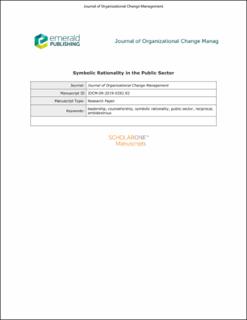Symbolic Rationality in the Public Sector
Peer reviewed, Journal article
Accepted version
Permanent lenke
https://hdl.handle.net/11250/2674662Utgivelsesdato
2020-06-23Metadata
Vis full innførselSamlinger
Sammendrag
The aim of this article is to describe work relations between leaders and counsellors in the Norwegian Labour and Welfare Administration (NAV). The study focus on communication, control, work ethos, worldview and Digital Production Management. This article is based on two empirical studies from the same research project at the Norwegian Labour and Welfare Administration (NAV) in the south of Norway called “Leadership and client orientation in NAV”. The research design led to a qualitative interview method being used to collect and analyse the opinions and experiences of the interviewees (Merriam, 2009). The study found (a) that leaders use DPM to control employees, (b) communicative and regulative aspects of working in NAV, (c) contradictory simultaneous work demands on leaders and counsellors, and (d) the symbolic rationality of work in NAV. The aspects (a) to (d) show a specific worldview in NAV. The study also found aspects of work ethos in NAV, such as a strong will to help and do well for the user, and at the same time meet NAV's financial and administrative requirements (Lundquist, 1998; Byrkjeflot, 2008). It is fruitful to describe this situation using the concept of symbolic rationality. Through symbolic rationality, the study has identified the possibility for further research on the hybrid professionalism of leadership and counsellorship, at three levels in the ambidextrous public sector. The first is the epistemological level, where the concept sets limits on how a social situation such as NAV can be spoken about and understood. A second level is the theoretical level, where categories and logics can be formed that are seen as being applicable to work in NAV. The third and final level is the practical level, where the concept of symbolic rationality and the meanings connected with it shape leaders’ and counsellors’ professional practice in the public sector.
